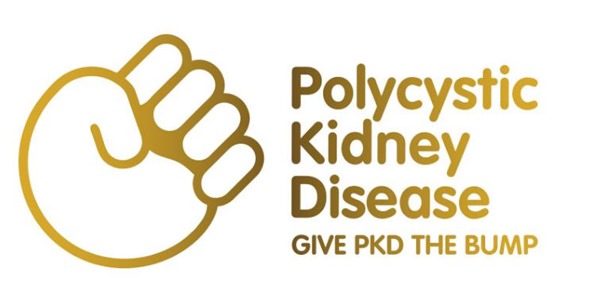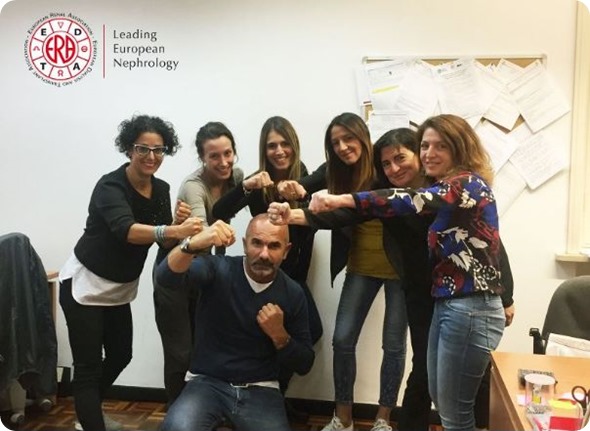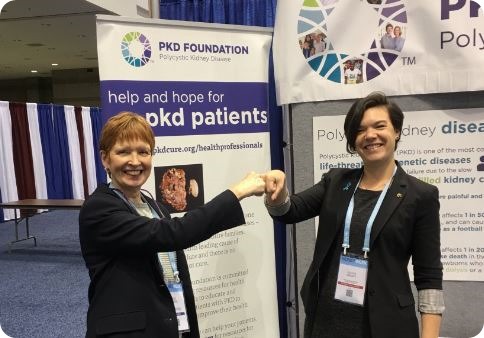Can you please give an overview of the social media campaign ‘Give PKD the Bump’?
We launched this campaign at the beginning of October 2016. It's the first time that we've ever had a campaign of this size and scope. It's a European campaign in multiple languages that's coordinated by six of the organizations that represent PKD patients in Europe.
The idea behind the campaign is fairly simple and, we hope, dramatic. We used the symbol of a clenched fist to signify the size of a normal, healthy kidney.

We want to emphasize, using this fist, that people who suffer with PKD have their kidneys grow or swell considerably above the size of a normal, healthy kidney, sometimes to the size of a rugby ball or American football.
PKD is quite unusual compared to other kidney diseases because generally the kidneys shrivel, but in PKD they swell enormously. This is due to the presence of fluid-filled cysts, that form from development in the womb and continue to grow over time, overwhelm the kidney, destroying its ability to function and causing kidney failure.
We are also saying we want to give PKD a ‘metaphorical fist bump’, pushing away the big kidneys and having them revert to the size of a normal fist. Hence the campaign name: Give PKD the Bump.
The fist bump is also a universal symbol that everyone around the world can recognize. It is used by a wide audience such as: celebrities, footballers, pop stars and even politicians.
Interestingly the fist bump is used by people who've just had kidney transplants to avoid shaking hands with others in order to prevent passing on germs, as palm to palm handshakes are more likely to transfer germs which could compromise their newly transplanted kidney.
Our symbol has got a lot of interesting connotations and meanings. Briefly what I’ve described, is the concept behind it.
How can people get involved and support the campaign?
There are many ways to get involved, especially online through social media, which is easy for people to do. A great example of the social media response that we’ve had since our launch is people taking short video clips of them fist bumping friends, family and colleagues, we’ve even had people fist bump their dogs. They then share this by posting their fist bump with the #BumpPKD on social media such as: Facebook, Twitter, Instagram and challenging their friends and family to do the same.
This allows our campaign to be shared through social media as well as reinforcing the message of giving PKD ‘the bump’ through the fist bump. We've also had people take and share photographs of events they've held where they've invited people to come forward and be photographed doing a fist bump.
Offline we've had people doing cake sales and other additional fundraising ideas. We're also selling golden lapel pins throughout Europe, designed in the shape of a fist that you can pin to your clothing and show your solidarity. These have been particularly popular.
We've also raised awareness at nephrology events which took place in Spain, Italy and Germany and PKD patient/family events in Switzerland and the UK.

Where will proceeds from the campaign go?
Most of the money will go towards funding for research, however, donations are being collected by each country separately.
In the UK, we have the ability to collect gift aid in addition to the donations. The campaign is set up so that a visitor on the campaign website can select the country that they wish to support and donate to.
There is also information about the campaign which can be read in their own language and this allows them to make their donation accordingly.

Why is research into biomarkers for PKD so important?
Biomarkers can be thought of like a fingerprint, you can use a biomarker to create an individual profile of a person with PKD. In the UK, for example, we support the study of particular biomarkers that can be detected in urine of PKD patients. The theory is that there's a protein biomarker present in the urine of somebody with PKD and it will be individual to them, hence the analogy of the fingerprint.
These biomarkers have a profile that corresponds to the stage of kidney function of the person with PKD. PKD is a very difficult condition to give somebody a prognosis for, even though it can be fairly easily diagnosed, you can't always tell somebody how quickly or slowly their kidneys are going to fail or even give them an idea of how severe or mild their PKD might be. As it's a genetic condition, it can be very variable, even in families who have the same genetic mutation.
People are studying biomarkers around the world and because results can be collected in a non-invasive test, by taking urine and blood samples, this can be easily integrated into a normal, routine appointment. Then over time, a trend will appear in the patient’s biomarker test results as kidney function changes over time.
The study we're doing in the UK is to build a biobank of urine and blood samples from patients attending the clinic at The Royal Free Hospital in London; here their medical records are matched with their blood and urine samples. A particular biomarker in the urine can then be matched against the corresponding clinical record and if the theory is correct, other clinics can use this biobank to help understand the stage of the disease their patient is likely to be at.
Although the biomarkers are individual to the patient, they are showing a pattern over time, which can be revealed through proteomic analysis and hopefully related to this biobank of patients. The goal is that this would be a non-invasive prognostic marker that can be used to help people manage and ultimately feel more empowered about their PKD.
Is this just a fundraising activity or is there more to the campaign?
The main goal of ‘Give PKD the Bump’ is to fundraise and raise awareness of PKD. PKD isn't particularly well-known amongst the public, along with many other kidney diseases. Over the years, our supporters and members have expressed how much it would mean to them to have more people aware of PKD.
Many people feel isolated with their condition, everybody's heard of cancer and other diseases such as cystic fibrosis and multiple sclerosis. PKD affects a huge number of people worldwide – nearly 13 million - but it is an invisible disease. This is therefore a joint awareness and fundraising campaign.
What impact do you hope the campaign will have?
We hope that with great awareness will come more support for the members of our individual organizations. We know there are a lot of people out there who get newly diagnosed and don't know where to go.
We hope that raising awareness, not just amongst the public and patients, but also amongst doctors and healthcare professionals, will mean that those newly diagnosed with PKD will be referred to us sooner, before they stumble across unhelpful information on the internet.
A main focus is to raise money for research. Although a lot is known about the biological mechanisms of PKD, there's still a lot of work that needs to be done on its symptomatic management because it's not just the kidneys that are affected, it is also livers and some patients are at risk of brain aneurysms.
It's a significant syndromic condition, which is under-funded and under-researched, as a lot of nephrology research is. In this respect, PKD is behind a lot of the other rarer conditions. So yes, public awareness but we want to raise money for meaningful research also.
What do you think the future holds for those living with PKD?
PKD remains an incurable condition, but realistically a cure is not likely to be achieved owing to its genetic nature and the presence of spontaneous mutations which cannot be pre-determined. However, recently there has been an increase in interest by pharmaceutical companies in treatments that slow down the progression of PKD.
Those diagnosed at an early stage with the condition have previously been told to essentially ‘go away’ until their kidney failed. We believe that increased awareness and better knowledge about PKD will help these people who are at this intermediate stage following diagnosis, which is often a very anxious period.
There is a lot of promise in the area of genomics, which has the potential to improve those who have complicated types of PKD by helping with an early diagnosis, especially for the children. Overall, we believe that people will begin to feel more comfortable and confident with this condition and not feel that they isolated and alone, which they have felt in the past.
Can you please explain the different types of PKD?
There are two types of PKD, and although they're both called Polycystic Kidney Disease there are differences between them. One of them is the dominant form called ADPKD, autosomal dominant PKD, which is the most commonly inherited kidney disease in the world and the fourth leading cause of kidney failure, affecting approximately 12 and a half million people.
Then there is a rarer form of PKD called autosomal recessive, ARPKD. Again, it's a polycystic kidney disease, but because it's recessive both parents of a child who inherits this condition must be carriers, which means they themselves don't have the condition.
ARPKD can be seen in babies and infants, often during pregnancy scans, whereas in ADPKD, the symptoms are not always so obvious ay this early stage, but develop over time. In ARPKD, the babies sometimes die before birth because of problems with massively cystic kidneys forming in utero.
In ADPKD, the kidneys continue to grow in size over time, even though it can be extremely difficult for the patient and painful to carry these enlarged kidneys. However, in ARPKD, the kidneys grow very large in the womb, which can often lead to death as there's no fluid for the unborn baby needed for survival. Their kidneys grow very large, very quickly and some of them have their kidneys taken out when they're born, the ones that are fortunate not to die. This also means that they must have a kidney transplant when they're quite young.
It’s important to understand, that there are two types of PKD and that the recessive form in particular is very devastating, especially for the young families that suddenly find that they have a baby which has these enormous kidneys.
Approximately 1 in 20,000 to 40,000 people suffer from the recessive form of PKD. In the UK , this equates to about 1,500 children, whereas the dominant form the figure is closer to 60,000 to 70,000 people that suffer with the disease.
Interestingly, the recessive gene is carried by a large number of people in the population, but it is only when two individuals that carry the recessive gene and conceive a child together will there be a possibility of the baby suffering from ARPKD. For this couple, who are both carriers, there is a 1 in 4 chance that the two genes will combine to give the full disease.
In ADPKD, the dominant form, in 9 out of 10 cases, you will have one parent with the condition, and then there is a 1 in 2 chance that their child will inherit it. However, approximately 1 in 10 cases of ADPKD will be from a spontaneous genetic mutation at the point of conception.
Is there any way to know if you are a carrier for ARPKD?
There is no indication of the disease when you are a carrier, as you are unaffected, and this is why it can be a great shock to those families who conceive a child with ARPKD, because their parents are not affected either by the disease even though they carry the mutated gene. It's only when two people who are carries conceive a child that the risk of the two chromosomes coming together that both have the gene mutations can cause ARPKDS.
But some people are finding out that they are carriers from ‘consumer’ genetic tests such as 23andMe.
As I said before, it's quite a high number of people in the general population that are carriers for ARPKD, about 1 in 150 people (fewer than cystic fibrosis which is approximately 1 in 49), and the odds of meeting someone who is also a carrier is quite low.
Where can readers find more information?
Information on PKD:
Information about the fist bump campaign and how to get involved:
- bumppkd.com/bumppkd/ - also includes basic information about PKD.
About Tess Harris
 Tess Harris is President of PKD International and CEO of the UK Polycystic Kidney Disease Charity. She is General Secretary of the Ciliopathy Alliance, a board member of FEDERG and a European Medicines Agency Expert.
Tess Harris is President of PKD International and CEO of the UK Polycystic Kidney Disease Charity. She is General Secretary of the Ciliopathy Alliance, a board member of FEDERG and a European Medicines Agency Expert.
Tess is a member of the NHS England Renal Transplant Clinical Reference Group and the first patient to chair a Clinical Study Group for Cystic Diseases within the UK Kidney Research Consortium.
She inherited ADPKD along with 3 siblings (one deceased) from her father (also deceased) and has other affected relatives: niece, nephew and great-nephews.
Prior to her charity roles, Tess was an entrepreneur in cosmetics, defense, spectacles and online leadership learning. She is a former international chairman of the Chartered Institute of Marketing and latterly lectured in e-business. In her spare time, she designs websites and is an aspiring novelist and children’s book writer.